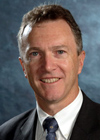
Rowan Gilmore
Rowan Gilmore received his undergraduate education at the University of Queensland, Brisbane, Australia, where he was awarded the University Medal and the B.E. degree in Electrical Engineering (Hons) in 1976, and his graduate education at Washington University in St. Louis where he was awarded the D. Sc. Degree in 1984. His research area was in the modeling of nonlinear behaviour in microwave MESFET circuits, as a result of which he was a pioneer in applying harmonic balance analysis to RF and microwave circuit design. Subsequently, while Vice President of Engineering with Compact Software, Dr. Gilmore led the introduction of Microwave Harmonica, the world's first commercial simulator applicable to the nonlinear design of microwave and RF circuits.
Dr. Gilmore gained his design experience over a number of years at Schlumberger, where he developed an RF tool for measurement of oil wells, and at Central Microwave, where he designed and developed numerous linear microwave power amplifiers, as well as oscillators and switching components. Subsequently, while at Compact Software, he was responsible for the development of their entire software suite of computer aided design tools. He was later Vice President at SITA-Equant, operator of the world’s most extensive data network, where he worked with a number of airlines and multinationals on their data telecommunications and IT needs. He spent eight years as the Chief Executive Officer of the Australian Institute for Commercialisation, located in Brisbane, Australia, working on establishing liaisons and facilitating technology transfer between universities and industry. He holds an appointment as Adjunct Professor of Electrical Engineering at the University of Queensland. He is currently a Director of EMSolutions, a specialist designer and producer of Ka-band microwave components and satellite systems, and Chairman of EMClarity, a producer of terrestrial point-to-point microwave communication systems.
Dr. Gilmore is a Chartered Engineer and Senior Member of the IEEE. He has published more than thirty articles in the field of microwave systems and circuit design, and has served on the editorial boards of the IEEE Transactions on Microwave Theory and Techniques, and of Wiley's International Journal of RF and Microwave Computer-Aided Engineering. He has been active in the education of graduate engineers in industry, having taught courses around the world to nearly fifteen hundred practicing RF and microwave engineers for the over a decade. With Dr. Besser, he is co-author of the widely read two-volume textbook ‘Practical RF Circuit Design for Modern Wireless Systems’.